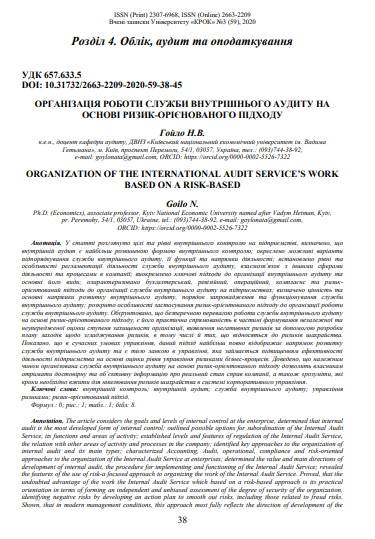ORGANIZATION OF THE INTERNATIONAL AUDIT SERVICE’S WORK BASED ON A RISK-BASED
DOI:
https://doi.org/10.31732/2663-2209-2020-59-38-45Keywords:
internal control, internal audit, Internal Audit Service, risk management, risk-based approachAbstract
The article considers the goals and levels of internal control at the enterprise, determined that internal audit is the most developed form of internal control; outlined possible options for subordination of the Internal Audit Service, its functions and areas of activity; established levels and features of regulation of the Internal Audit Service, the relation with other areas of activity and processes in the company; identified key approaches to the organization of internal audit and its main types; characterized Accounting, Audit, operational, compliance and risk-oriented approaches to the organization of the Internal Audit Service at enterprises; determined the value and main directions of development of internal audit, the procedure for implementing and functioning of the Internal Audit Service; revealed the features of the use of risk-a focused approach to organizing the work of the Internal Audit Service. Proved, that the undoubted advantage of the work the Internal Audit Service which based on a risk-based approach is its practical orientation in terms of forming an independent and unbiased assessment of the degree of security of the organization, identifying negative risks by developing an action plan to smooth out risks, including those related to fraud risks. Shown, that in modern management conditions, this approach most fully reflects the direction of development of the Internal Audit Service and is the link in management that is engaged in improving the efficiency of the enterprise based on assessing the level of risk management of business processes. Established that a properly organized internal audit service based on a risk-based approach will allow owners to obtain reliable and objective information about the real state of affairs of the company, as well as understand what steps need to be taken to level the risks of fraud in the corporate governance system.
Downloads
References
Крышкин О. Настольная книга по внутреннему аудиту. Риски и бизнес-процессы : учебное пособие. 5-е вид. Москва : Альпина Паблишер, 2013. 478 с.
Малышевская М. Внутренний контроль в банке: проблемы и парадоксы. Бухгалтерия и банки. 2005. № 8.
Михайлов А. М. Риск-ориентированный внутренний контроль и аудит. Экономика и управление: проблемы и решения : материалы международной заочной научно-практической конференции от 21.11.2011. URL: http://www.sibac.info/index. php/2009-07-01-10-21-16/609- 2012-01-17-10-38-42/.
Панков В. В., Тартаршвили Т. Т. Аудит эффективности системы управления рисками коммерческого банка. Аудит и финансовый анализ. 2010. № 3.
Толчинская М. Н. Риск-ориентированный подход к службе внутреннего аудита. Фундаментальные исследования. 2015. № 10 (часть 3).
Шарапова И. С., Юга И. П., Кваско И. А. Концепция риск-ориентированного аудита. Молодой учёный. 2017. № 10 (144).
Міжнародні стандарти професійної практики внутрішнього аудиту. URL: http://iia-ua.org/wp-content/uploads/2013/08/IPPF-Standards-2017-Ukrainian.pdf.
Маккеон М., Уайтли Ф. Избавьтесь от стереотипов : монография. Днепропетровск : Баланс-Клуб, 2003. 160 с.



